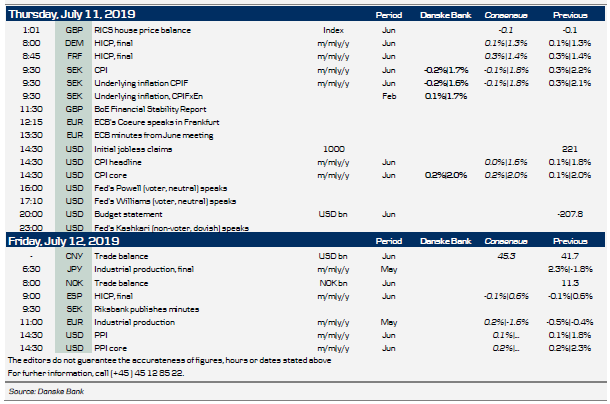Market movers ahead
The latest Fed and ECB meeting minutes will be scrutinised for signs of the next steps in their monetary policy easing.
China will be in focus on a potential restart of US-China trade talks and any comments on this.
The euro area Q2 GDP flash report could be bad news for the market.
US core inflation expected to remain unchanged.
Nordic inflation numbers are likely to point in different directions (Sweden's core drop, Norway's core climb and Denmark's headline remain broadly unchanged).
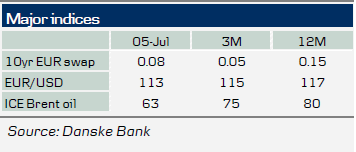
Weekly wrap-up
Despite the trade ceasefire between the US and China, big obstacles remain in reaching a deal that satisfies both sides and we still expect a rocky path ahead.
Christine Lagarde was surprisingly nominated as the next ECB president but this does not change our expectation of a sizeable easing package in September.
Tensions between the US and Iran continue to build, posing a danger to Middle East stability.
Macroeconomic numbers continue to paint a sombre picture of the global economy.
Note that the Weekly Focus will take a break until 9 August.
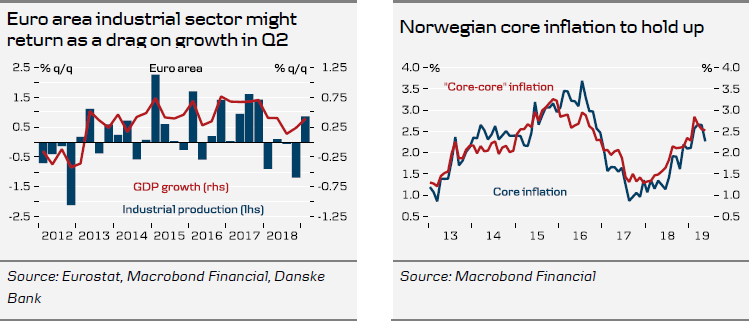
Global
- In the US, next week is quiet in terms of data releases. CPI core is due out Thursday and likely rose +0.2% m/m in June, which translates into an unchanged annual inflation rate at 2.0% y/y.
Next week also brings several Fed speeches and FOMC meeting minutes on Wednesday. It will be interesting to learn about the different stances within the Fed. As repeated at the last FOMC meeting, the Fed ‘will act as appropriate to sustain the expansion’. Our view is that the Fed will cut rates in July by 25bp and a total of 75bp in the second half of 2019 (that is July, September and December). The trade war is an important risk to our outlook in both directions.
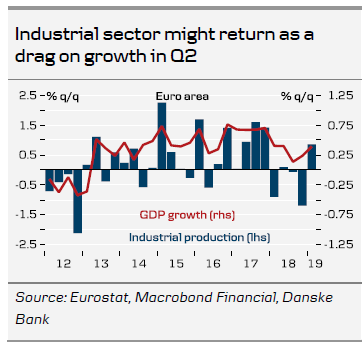
- In the euro area, there are two interesting releases on the agenda. The ECB minutes from the June meeting will be out on Thursday. At the press conference, Draghi stressed that the governing council (GC) discussed several options at the meeting including a rate cut and a restart of QE. Draghi in his Sintra speech sent a strong signal to markets that more stimulus is coming. Hence, markets will look out for clues in the minutes on how ready the GC stands in announcing immediate steps already at the 25 July meeting. We still lean towards an announcement of an easing package coming in September (see New ECB call - rate cut and restart of QE).
On Friday, we get a further piece of the puzzle on where euro area GDP growth will arrive in Q2 with the industrial production data for May. The April figures pointed to a weak start for the industrial sector into Q2 and business surveys such as the PMI and Ifo point to further setbacks ahead. Hence, we think markets could be in for additional negative surprises when it comes to hard economic data in the coming months, as we also discussed in Euro Area Research - Catching up with reality.

- News out of the UK about Brexit is likely to be limited next week with the outcome of the Conservative Party leadership contest not set to be announced until 22 July. However, on the data front we get more insight in where growth in Q2 19 will arrive with the monthly GDP estimate for May due on Wednesday. After a strong start to the year helped by pre-Brexit stockpiling, the sector has struggled of late as PMIs have fallen back. Overall, we remain sceptic that the economy can maintain its 0.5% q/q growth momentum from Q1.
- Focus in China will be on the restart of the US-China trade talks and any comments regarding this. On the data front, we get money and credit, CPI/PPI and trade balance. On consumer price inflation, we have seen an increase lately due to higher food prices, which is related to the African swine fever (see chart). Producer price inflation (PPI) on the other hand is facing downward pressure from lower commodity prices. We look for a decline from 0.6% y/y to 0.3% y/y in line with consensus. Trade data will give more clues to the state of exports in June following the escalation of the trade war. The data are quite volatile, though, so they should be taken with a grain of salt. The money and credit data will give more clues on how much the monetary easing over the past year is feeding through to the economy. There has been some tentative improvement in recent months.
- In Japan, we get May total cash earnings on Tuesday. They have looked dire al through this year, as businesses have been extra aware of costs in the light of slowing global demand. This is bound to weigh on private consumption and inflation.
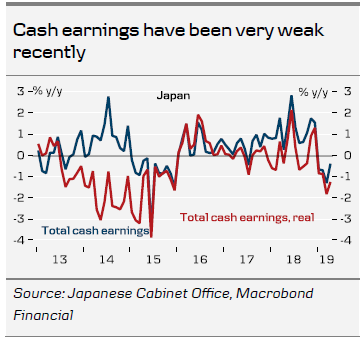
Scandi
- In Denmark, export figures for May are due on Tuesday. Goods exports have performed remarkably well over an extended period taking into account the global economic slowdown. Service exports, on the other hand, have slowed. The Danish shipping fleet, which accounts for half of service exports, is sailing in choppy waters currently, as growth in global trade has more or less evaporated.
On Wednesday, we get inflation figures for June. Following a big drop in May, we expect inflation unchanged at 0.7%. Clothing prices should start to weigh less after very big declines recently. Package holidays, on the other hand, are likely to pull the other way along with declines in gasoline prices.
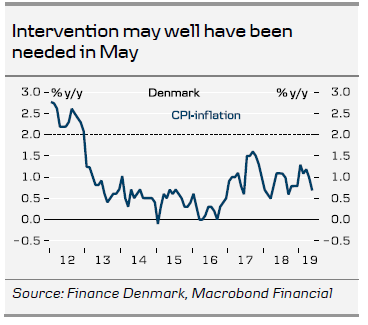
- In Sweden, June CPIF inflation is expected to slow considerably to 1.6 % y/y, down from 2.1 % y/y in May. This is spot on the Riksbank’s forecast. In our forecast, this is largely an energy effect, with both fuel and electricity falling sharply and pulling down CPIF by 0.15pp each. However, we differ from the Riksbank in the composition: we expect an unchanged print for CPIF excluding Energy (1.7 % y/y), whereas the Riksbank expects a slight increase to 1.8% y/y.
As May turned out higher than expected and contrary to our view that risks were skewed to the downside, how do risks appear in June? Given that May price increases were unusually high for clothing, furniture and restaurants/accommodation compared to the past couple of years, there is probably a downside to these, about 0.1pp. Upside risks are probably related to higher food prices.
Prospera inflation expectations are also on the agenda but the May household consumption indicator is probably more important. Car registrations remaining negative (-15.3 % y/y according to Bil Sweden) and retail sales (-0.5 % y/y) being the weakest since September 2011 suggest there is a risk of a deeper dive into negative growth.
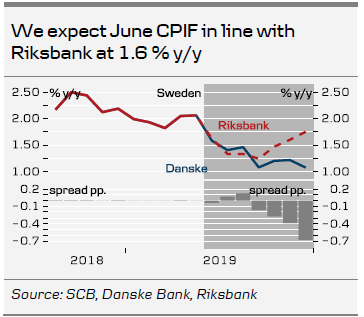
- In Norway, core inflation slowed rather unexpectedly to 2.3% y/y in May. With wage growth accelerating, there is little reason to expect domestic inflation to fall and the krone has strengthened less than anticipated, meaning that imported inflation will also hold up. Much of the decrease from April was also due to food and airfares, two components that can be highly volatile from month to month. We expect both to correct in June, giving core inflation of 2.4% y/y, with the risk slightly to the upside. The week also brings GDP for May. The monthly GDP figures have fluctuated considerably from month to month and have proved difficult to predict because of big swings on the supply side (power and agriculture) due to weather conditions. Norges Bank’s regional network survey indicates growth in mainland GDP of around 3% y/y for the rest of this year. Much of this will be driven by the service sector, on which we have little interim data, so it is on an uncertain basis that we forecast an increase in mainland GDP of 0.2% m/m.
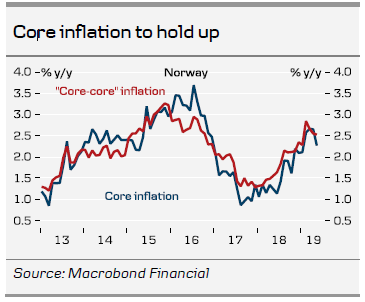
Market movers ahead
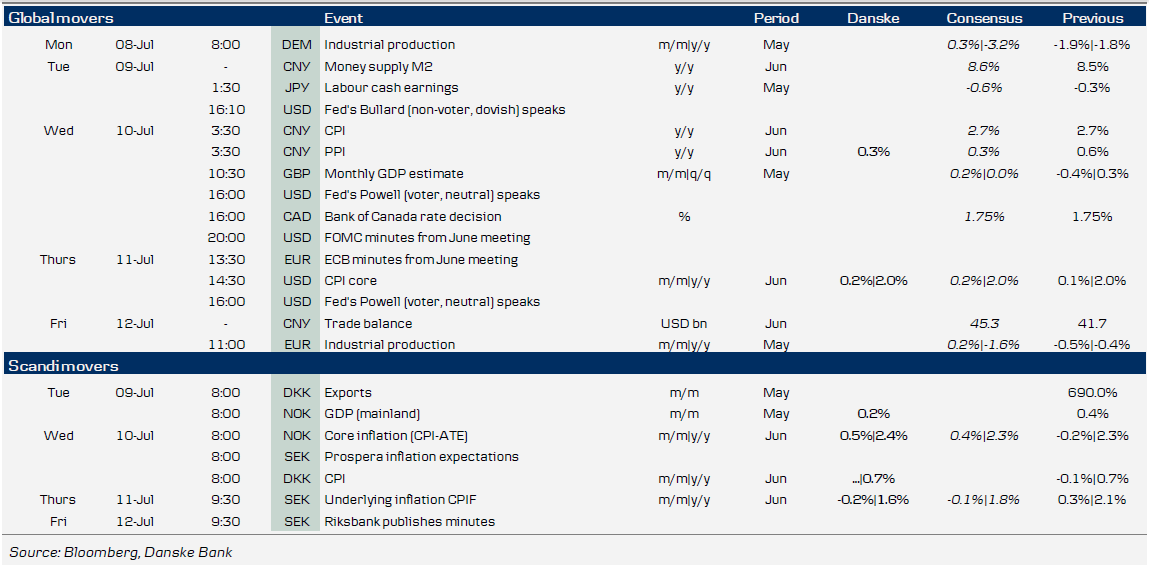
Weekly wrap-up
Main macro themes—trade truce fails to lift sentiment
As widely expected, the Xi Jinping-Donald Trump meeting at the weekend’s G20 meeting in Japan ended with a ceasefire in the trade war. The two sides agreed to restart the trade negotiations, the US promised not to apply new tariffs and no deadline was set for the completion of the talks. Trump also lifted the export ban on Huawei, at least partially. The ceasefire is good news in the sense that it confirms that both sides want to make a trade deal. However, big obstacles remain to reach a deal that satisfies both sides and we still expect a rocky path ahead. The still-tense relationship became evident when President Trump this week strongly condemned China and Europe for manipulating their currencies in an unfair way.
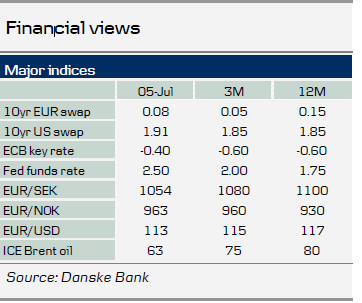
The European Game of Thrones reached its peak this week. Following intense negotiations, EU leaders struck an agreement on the succession race for the EU Commission and ECB presidency. The new head of the commission is Ursula von der Leyen – a seasoned centrist politician from Angela Merkel’s CDU party. However, the most important appointment from a market perspective was Christine Lagarde as President of the ECB. We do not know much about Lagarde’s thinking on monetary policy but she has been open to unconventional monetary policy. As such, we do not see a reason to change our ECB call for a package deal in September consisting of a 20bp cut, a QE restart of EUR45-60bn, tiering and extended forward guidance (see more in ECB Research – New ECB call – rate cut and restart of QE, 18 June).
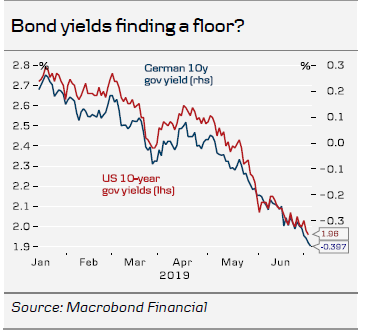
Tensions between the US and Iran continue to build, posing a danger to Middle East stability. After Iran warned that it will breach the enrichment agreement following the US choosing to abandon the agreement, President Trump warned that the Iranian threats will ‘come back to bite them like nobody has been bitten before!’. The situation could escalate further if Europe fails to provide economic assurances to Iran by 7 July, as Iran will then go ahead with its plans. Iran would then proceed to breach the nuclear agreement. Meanwhile, OPEC agreed to maintain its production cuts for another nine months. We see oil prices climbing over the next few quarters as a result of the cut and geopolitical concerns.

Macroeconomic numbers continue to paint a sombre picture of the global economy. US ISM manufacturing is on the weak side (55.1 versus Consensus of 56.0). New orders and employment are down, albeit from high levels. Market-based inflation expectations fell back below the levels before Mario Draghi and the Fed hinted at new stimulus, suggesting that both central banks have a big task to reignite inflation dynamics.
Financial market developments
While equity markets cheered the trade truce between China and the US, fixed income markets were less upbeat. Stock markets in the US climbed to an all-time high and the European and emerging market equity indices saw good support. However, US and German 10-year yields initially rose on the back of the weekend’s agreement but later in the week fell again as optimism wavered. Italian bonds rallied after the EU Commission held off from launching EDP at this stage after the government promised to rein in some of its spending plans for 2019. However, we still see a fair chance of a renewed stand-off with the EU in the autumn over the 2020 budget. In FX markets, EUR/SEK fell after the Riksbank kept its rate path unchanged, which was a bit more hawkish than the market had expected.
Scandi update
Denmark – no FX intervention in June
Danmark Nationalbank (DN) did not intervene in the FX market in June. It has not intervened since January.
The Danish debt management office has published its revised issuance plan for H2. It has raised the issuance target for government bonds by DKK10bn to DKK75bn, while leaving the target for t-bills unchanged at DKK30bn. The increase in issuance target reflects an additional DKK20bn in government purchase of mortgage bonds, i.e. the larger issuance is not due to a worsening of public finances or the new government. Issuance will be centred in 2Y and 10Y nominal bonds.

Sweden – Riksbank kicking the can down the road
The main takeaways from the Riksbank’s July meeting were: no change to the repo rate path versus April, where a reduction was expected; no change to QE, in line with expectations; no reservations to the decision; very small changes to the macro forecast, both growth and inflation. In essence, this was a ‘wait and see’ meeting.
Our take is that the Riksbank is describing the Swedish economy as strong, with resource utilisation still higher than normal. The Riksbank acknowledges that global risks appear to have intensified but this has not been incorporated in the KIX-weighted policy rate forecast (ECB, Fed, BoE and Bank of Norway). That is slightly reduced, but sees higher rates in 2021. The big three of these have clearly signalled rate cut intentions and this is also to different degrees priced into money markets. Note, however, that the Riksbank is open to following: ‘The downturn in international bond yields can indicate that global interest rates going forward will be low for a longer period to come’ and ‘if the conditions for inflation were to change, monetary policy will be adjusted.’ This suggests that if the ECB and the Fed cut, the Riksbank will adapt.
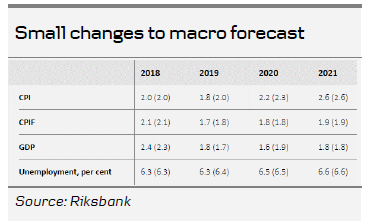
Norway – manufacturers hoist yellow flag
The PMI fell unexpectedly to 51.9 in June, whereas we had predicted an increase to 54.5. We have long argued that strong growth in oil investment has been propping up manufacturing activity despite the global slowdown. The June figures could be a sign that the negative effects from the global economy are starting to dominate, and that we are entering a weaker period for Norwegian manufacturers. This is supported by a sharp fall in the index for export orders. On the other hand, the PMI can be highly volatile from month to month, and drops of this magnitude (2.2 points m/m) are not uncommon and have in fact occurred seven times since August 2017. Nor were there any signs of a manufacturing slowdown in the regional network survey published only a fortnight ago, a far more stable indicator than the PMI. As mentioned before, it would appear that oil-related industries weigh somewhat less in the PMI than in reality, which may explain part of the difference. Obviously we will not be making any changes to our outlook at this stage, but we will be keeping an eye on other manufacturing indicators, next up being Statistics Norway’s tendency survey on 23 July.

Latest research from Danske Bank
5/7 Inflation Preview Sweden: June CPIF to be in line with Riksbank
June CPIF inflation is expected to slow considerably to 1.6% y/y, down from 2.1% y/y in May.
3/7 Euro Area Macro Monitor: ECB's credibility on the line
Markets do not believe in the ECB's inflation target. A big easing package is needed to restore credibility, though the impact on the economy is likely to be muted
3/7 Riksbank Comment - Kicking the can down the road
Main takeaways: No change to the repo rate path vs April where a reduction was expected.
3/7 ECB Research - Lagarde to take 'one of the most difficult' jobs
Following intense negotiations, EU leaders have struck an agreement on the succession race for the EU Commission and ECB presidency.
3/7 Monthly Executive Briefing: send in the central bank cavalry (again)
The global macroeconomic situation continues to show signs of weakness
2/7 Flash Comment Denmark: No FX intervention in June
Danmark Nationalbank (DN) did not intervene in the FX market in June. It has not intervened since January.
2/7 China Leading Indicators - Short-term weakness, but no hard landing
Our view. PMIs are set to remain weak in the short term, but there is no sign of a hard landing. On the other side of a trade deal, the economy should recover again.
30/6 US-China Trade - Ceasefire a reality but no quick fixes to reach a deal
As widely expected, the Xi-Trump meeting ended with a ceasefire in the trade war. The export ban on Huawei was also lifted, at least partially.
Macroeconomic forecast
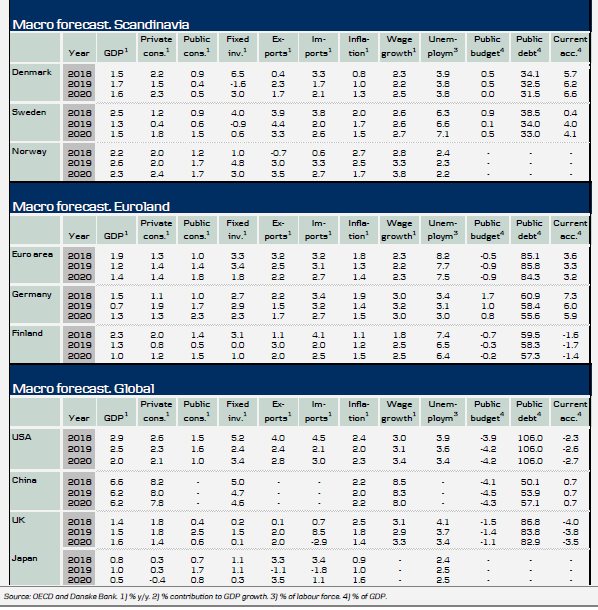
Financial forecast
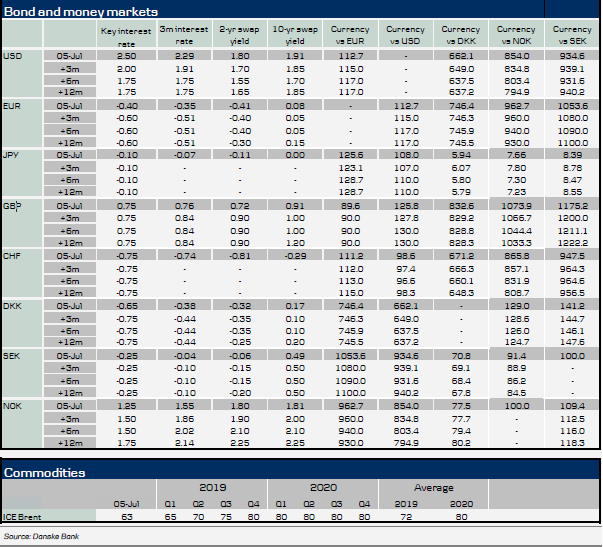
Calendar

